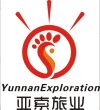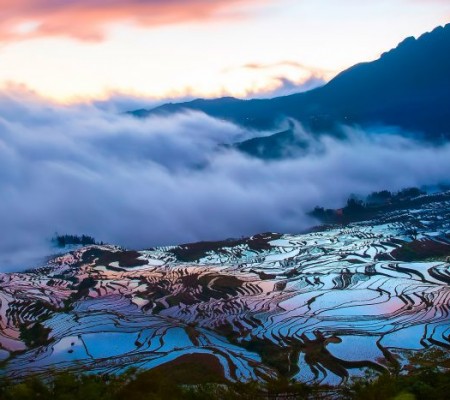
Luobenzhuo Bai Ethnic Town in Lushui City, Nujiang
Luobenzhuo Bai Ethnic Township is located in the northern part of Lushui City, Nujiang Prefecture, Yunnan Province, within the Nujiang River Valley. Below is a detailed introduction to Luobenzhuo Bai Ethnic Township:
Geographic Location and Administrative Divisions
-
Location: Luobenzhuo Bai Ethnic Township is situated in the northern part of Lushui City. It borders Lantsang County to the east, Gudeng Township to the south, the Myanmar border along the crest of Gaoligong Mountain to the west, and Pipa Nu Ethnic Township in Furong County to the north.
-
Administrative Divisions: As of June 2020, Luobenzhuo Bai Ethnic Township consists of 1 community and 8 administrative villages, with the township government located in Tuotuo Village.
Population and Ethnic Composition
-
Population: The township has a total of 2,696 households and a population of 11,133 people.
-
Ethnic Composition: The township is home to Bai, Lisu, and Nu ethnic groups. The main ethnic group is the Bai sub-branch “Lei Mo people,” who account for 66.6% of the population. The Lisu ethnic group makes up 32.9%, and other ethnic groups account for 0.36%.
Topography, Climate, and Natural Resources
-
Topography: Located in the Nujiang River Valley, the township has a topography characterized by high elevations in the east and west and lower elevations in the center, dominated by mountainous terrain. Major mountain ranges include the Gaoligong Mountain Range and the Biluo Snow Mountain Range. The highest peak, Shuimo Shi, is located at the border between Jinping and Oga villages and Myanmar, with an elevation of 4,140.7 meters. The lowest point, “Yiwu Jiujiang Beach,” is located at the border between Luobenzhuo Bai Ethnic Township and Gudeng Township, with an elevation of 1,040 meters.
-
Climate: The township experiences significant vertical climatic variations, with three distinct climate zones: cold in the high mountains, temperate in the mid-mountain areas, and hot in the river valleys. The average annual temperature is 23°C, with extreme highs of 36°C and extreme lows of 4°C. The frost-free period averages 286 days, with an average annual sunshine duration of 2,478.4 hours and an average annual rainfall of 1,023 millimeters.
-
Natural Resources: The township has vast mountainous areas, a humid climate, and abundant plant resources. It is rich in agricultural products and medicinal herbs such as lacquer, tung oil, beans, potatoes, and traditional Chinese medicines like Huanglian and Mu Xiang.
History and Culture
-
Historical Evolution: From 1932 to 1949, the area was part of the Jinman Township under the Bijiang Administrative Bureau. From 1950 to 1957, it was the Fourth District of Bijiang County. In 1959, it was converted into a commune. In 1961, it was renamed the Fourth District of Bijiang County. In 1969, it became the Wuqi Commune. In 1981, it was renamed Luobenzhuo Commune. In 1984, it was upgraded to Luobenzhuo District. In December 1986, after the dissolution of Bijiang County, Luobenzhuo District was incorporated into Lushui County.
-
Cultural Heritage: The main ethnic group in Luobenzhuo Bai Ethnic Township, the Bai sub-branch “Lei Mo people,” has a long history of cultural traditions and customs, including unique clothing, dances, songs, and musical instruments. The Peach Blossom Festival, held in late February or early March when peach blossoms bloom and cuckoos sing, is a significant cultural event. During the festival, various folk activities are held to wish for family happiness and a bountiful harvest.
Economic Development
-
Economic Income: By the end of 2002, the total rural economic income of the township was 7.3893 million yuan, with a grain output of 3 million kilograms. The average per capita income of farmers was 662.46 yuan, and the average per capita grain availability was 273.6 kilograms. Poverty remains widespread and severe.
-
Development Potential: Luobenzhuo Township shares a border with Myanmar and has a long history of cross-border marriages and trade. The ongoing construction of the Pianma Port Oga Channel will further promote bilateral economic exchanges and increase the development of resources such as timber, minerals, and medicinal herbs, creating opportunities for economic cooperation and resource utilization on both sides of the border.

 7 Days GolfingTour
7 Days GolfingTour
 8 Days Group Tour
8 Days Group Tour
 8 Days Yunnan Tour
8 Days Yunnan Tour
 7 Days Shangri La Hiking
7 Days Shangri La Hiking
 11 Days Yunnan Tour
11 Days Yunnan Tour
 6 Days Yuanyang Terraces
6 Days Yuanyang Terraces
 11 Days Yunnan Tour
11 Days Yunnan Tour
 8 Days South Yunnan
8 Days South Yunnan
 7 Days Tea Tour
7 Days Tea Tour
 8 Days Muslim Tour
8 Days Muslim Tour
 12 Days Self-Driving
12 Days Self-Driving
 4 Days Haba Climbing
4 Days Haba Climbing
 Tiger Leaping Gorge
Tiger Leaping Gorge
 Stone Forest
Stone Forest
 Yunnan-Tibet
Yunnan-Tibet
 Hani Rice Terraces
Hani Rice Terraces
 Kunming
Kunming
 Lijiang
Lijiang
 Shangri-la
Shangri-la
 Dali
Dali
 XishuangBanna
XishuangBanna
 Honghe
Honghe
 Kunming
Kunming
 Lijiang
Lijiang
 Shangri-la
Shangri-la
 Yuanyang Rice Terraces
Yuanyang Rice Terraces
 Nujiang
Nujiang
 XishuangBanna
XishuangBanna
 Spring City Golf
Spring City Golf
 Snow Mountain Golf
Snow Mountain Golf
 Stone Mountain Golf
Stone Mountain Golf













